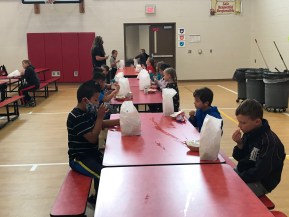
Spitler Elementary School students eat lunch in their classroom.
Pirate News: Adapting to a new normal during COVID-19.
Pirate News is a service of Hart Public Schools in cooperation with Oceana County Press.
By Allison Scarbrough, Editor.
HART — Although the school atmosphere has changed due to COVID-19, students and staff at Hart Public Schools are finding normalcy.
Students returned to in-person instruction at the start of the 2020-21 school year, which began Sept. 8. Hart students also have the option to do virtual instruction instead of attending class in person.
“As far as the first week, it went fantastic for the most part,” said Superintendent Mark Platt. “Once the kids came back, it kind of settled back into normal.
 “We know without a doubt that the vast majority of the parents want their kids in school.
“We know without a doubt that the vast majority of the parents want their kids in school.
“Any school that is doing an in-person situation, the biggest challenge hasn’t really been this first week, it was during the summer trying to plan for this first week,” said Platt. “The planning took place almost as soon as school got out (last spring).”
The school superintendents in the region requested that the West Shore Educational Service District create subgroups to “divide and conquer” handling certain focus areas during a pandemic, such as special education, transportation, facilities, curriculum, and pupil accounting.
 With the fluidity of the situation, educators are constantly making plans and changing plans due to rules handed down from the state. “Right when you thought you had it all planned out, somebody would change the rules. One of the things we’ve learned is don’t plan too far ahead.”
With the fluidity of the situation, educators are constantly making plans and changing plans due to rules handed down from the state. “Right when you thought you had it all planned out, somebody would change the rules. One of the things we’ve learned is don’t plan too far ahead.”
The pupil accounting area has been one of the most challenging. “The per-pupil allotment is how we’re funded, and the pupil accounting is all of the documentation that we have to have to prove that Johnny was in school today.”
With some students doing remote learning, accounting for those students’ attendance has been difficult. “It’s really hard to count a virtual student,” Platt said. “There has to be evidence of two-way communication,” such as a screenshot of a Zoom meeting.
 “We have the ability to tell if they’re actively engaged or not. If we notice that Johnny is not actively participating, we’re going to be contacting home and say, ‘Look, you signed up for this. He’s not cutting it.’ Any parent that signed up for virtual, they’re taking a certain degree of ownership that is higher than if the child was face-to-face. That was made very clear to parents.”
“We have the ability to tell if they’re actively engaged or not. If we notice that Johnny is not actively participating, we’re going to be contacting home and say, ‘Look, you signed up for this. He’s not cutting it.’ Any parent that signed up for virtual, they’re taking a certain degree of ownership that is higher than if the child was face-to-face. That was made very clear to parents.”
So far, parents are doing their jobs and keeping their students engaged virtually. “So far, so good,” said Platt at end of the first week of school.
Virtual attendance is easier at the elementary level because instruction is handled through the Google Classroom platform. “So, the teacher can literally see the kids,” he said. There are about 100 students out of over 400 Spitler Elementary School pupils who are enrolled in virtual learning.
 “The rules for virtual are not new, because virtual education has been around public schools now for awhile. But because of the mass amount of students that were going virtual statewide, the state cranked up the pupil accounting rules after we had already passed the plan. Fortunately, it doesn’t really impact our plan as far as what was approved by the school board, but what it does impact is how we do things.”
“The rules for virtual are not new, because virtual education has been around public schools now for awhile. But because of the mass amount of students that were going virtual statewide, the state cranked up the pupil accounting rules after we had already passed the plan. Fortunately, it doesn’t really impact our plan as far as what was approved by the school board, but what it does impact is how we do things.”
“There is a lot of documentation required, and it’s that documentation is why we are now getting out at 2:45 p.m. every day,” he said. School normally ended at 3:15 p.m. “The kids getting out at 2:45 allows for the teachers in that last half hour to handle the very complicated documentation process.”
 “The documentation is rather robust,” Platt said. “Also the preparation can be rather robust. That 2:45-3:15 p.m. timeframe is used for those activities.”
“The documentation is rather robust,” Platt said. “Also the preparation can be rather robust. That 2:45-3:15 p.m. timeframe is used for those activities.”
The first day of school at Hart has been a half-day for many years, and the shorter day serves as a “dress rehearsal” for the rest of the school year. After the end of the first full day of school, several students opted out of virtual learning and returned to face-to-face instruction.
A school survey performed before school resumed indicated that families wanting their students to do virtual instruction was as high as 37 percent. However, that number has continued to drop, Platt said. After the second day of school, the number dropped dramatically. “There were 20 kids at the high school that wanted to come back.”
 The school is in the process of finalizing the percentage of virtual students. As of late last week, that number was around 25 percent.
The school is in the process of finalizing the percentage of virtual students. As of late last week, that number was around 25 percent.
It will probably go down in the fall but could rise in the winter during flu season. With the recent decision of the Michigan High School Athletic Association to bring back fall sports, more students decided to switch from virtual to in-person learning, Platt said. Although, they can play sports as virtual students.
Students can switch to a different learning format (in-person vs. virtual) at the close of a marking period. That is particularly important at the high school level due to credit acquisition.
 Like in-person students, districts are required to provide meals for their virtual students, so that percentage is important data.
Like in-person students, districts are required to provide meals for their virtual students, so that percentage is important data.
Many changes have taken place in the cafeterias and with lunch schedules to ensure proper distancing. There are even outdoor dining options during the mild weather. “Lunch is the most complicated thing we’re doing right now,” he said. It is also constantly evolving as the number of in-person students grows.
Elementary classes alternate between eating in the classroom and eating in the cafeteria to ensure social distancing.
Bussing is probably the second most difficult task for the school district in the midst of the pandemic. The district was fortunate to be able to add a route, which allows for less crowding on the busses. Students must wear masks regardless of age, and they are required to use hand sanitizer when boarding.
 Busses must be both cleaned and sanitized after every run, Platt said.
Busses must be both cleaned and sanitized after every run, Platt said.
“We have fewer people riding busses right now. More parents are choosing to drive their kids.”
One way to limit elementary students’ exposure is a process called “cohorting.” The same group of students stays in the same classroom throughout the school day.
“We all know that kids are social creatures for the most part,” he said. “They want to be with their friends.”
Students are not required to undergo health screenings to enter the buildings, although staff must do a daily self-screening online. The district urges parents to be more vigilant about monitoring their students’ health.
If someone tests positive for COVID-19, the district will work directly with the health department, which will then do contact tracing. “It doesn’t mean that if somebody tests positive for COVID in the school, that you have to shut a classroom down. It doesn’t mean that you have to shut the school down. It just means that when they do the contract tracing, they’re going to be looking at who this person who tested positive came into contact with 15 minutes or more. “One of the best ways to minimize that is to be 6 feet apart and mask up.”
 The most visible change for students during the COVID-19 crisis is the wearing of masks.
The most visible change for students during the COVID-19 crisis is the wearing of masks.
The ESD conducted a survey early in the summer, and results showed that the mask was going to be a “very contentious issue,” Platt said. “Interestingly enough, the kids and the staff have been fantastic. We’re not experiencing kids not wearing their masks on purpose. We’re not experiencing parents coming in and thinking they’re going to do what they want to do and disregard the masks. They wouldn’t be allowed in.”
Although this issue hasn’t arisen at HPS, if a student refuses to wear a mask, they will be assigned to virtual instruction. “If you decide you’re not going to play by the rules, we will assign you to virtual school.”
Navigating through the COVID climate has been challenging, but it has also been enlightening. “While there is a lot of focus on the negative sides of the school year in terms of masks and the pandemic, there are some really interesting positives. It really has forced us to get a lot better with providing and using technology at a significantly increased level than we have in the past.
“We started to learn a little bit more about our students,” Platt said. Educators found that virtual learning is better for some students, especially those who work. “We’re probably always going to offer a virtual aspect moving forward long after the pandemic. Every school district struggles to reach every kid. So if there is a segment of kids that want an education, but maybe don’t want to participate in the activities of the building and they need to work, I think we need to have a product for these kids. That’s what we learned really quickly. Just like in business, if you see a need, it’s really an opportunity.
“When you go to a high school, there is a certain amount of school spirit that is there, and a lot of it is tied to band, drama and athletics. If that’s gone, you have a skeleton left. Thank goodness athletics are back even though they’re really unique.”
Football, volleyball, and soccer athletes are required to wear masks when competing. Cross country runners do not have to wear masks while running, however.
“The other issue we’re dealing with in sports is spectator crowd size.” The rule is only two spectators per athlete can attend events. This means there will be no marching band performances at football games. “We can’t stay below our group size out there if we include the band, because our group size has to be 100 or less.”
Football season kicks off Friday, Sept. 18, and it runs six weeks through Oct. 23. “Even though the event is outside, the fans have to wear masks.” Another unique aspect of the COVID gridiron schedule is that every team in the state makes the playoffs.
With the 100-person limitation, schools will lose out on admissions and concessions revenue.
School administrators are working out how homecoming will be handled. A homecoming date has not yet been nailed down, although it is expected to happen in early October.
“We don’t want to do something that’s going to get us in trouble, but we want to do something that allows the students to enjoy and carry on the tradition.”
Working out the logistics of the homecoming court and dance while maintaining a 6-feet distance will be difficult.
Hiring substitute teachers is another obstacle in the COVID environment. A system is being set up at Spitler where they can acquire subs internally by having the virtual teacher fill in. “That’s going to be one of our bigger challenges for the whole year.”
“The staff has been phenomenal. I couldn’t be more pleased. They have been terrific about coming back and they have been really good about asking questions. If there are folks who are scared — and there are — they have been really open about that and I appreciate that. We need them to tell us if that’s the case so we don’t put them in a difficult situation.”
The school district will continue to keep the community informed of COVID changes through live Facebook forums.
Please consider helping fund local news. Mason County Press and Oceana County Press are available for free thanks to the generous support of our advertisers and individuals who support our service. Click on the PayPal donation button located on the top right of our website.
This story is copyrighted © 2020, all rights reserved by Media Group 31, LLC, PO Box 21, Scottville, MI 49454. No portion of this story or images may be reproduced in any way, including print or broadcast, without expressed written consent.







































.png)



